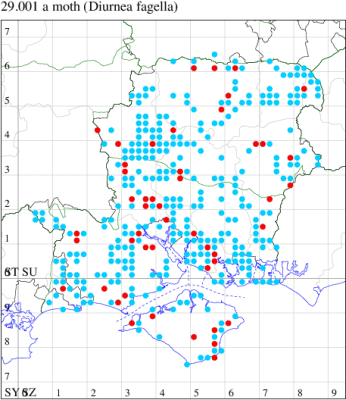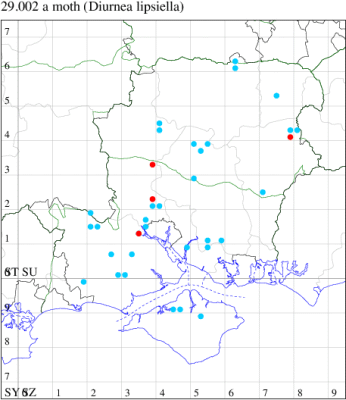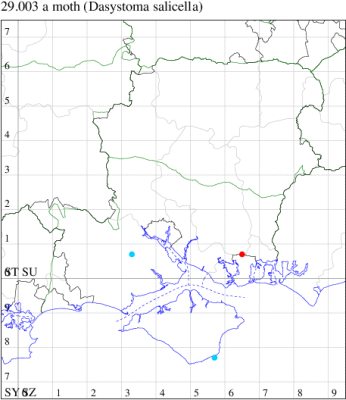2021 Annual Report for: Chimabachidae / Chimabachinae
For species seen in 2021 that had less than or equal to 100 records, full details are included; for more common species, the earliest, latest and highest count by vice-county are shown. The narrative for each species is taken from the main Hantsmoths website, and it is possible that some information on abundance and occurrence can get out of date, as it is impossible to keep up with all changes; however it should give a good introduction to each species. The tables in each species account summarise the previous status, and that for the current year.
For the maps, all records prior to 2021 are shown by a blue dot (the larger the dot, the more recent), with the current year's records shown in red. As previous records are superimposed on any report for 2021, new sites have greater emphasis (i.e. will show as 'more red').
In the species accounts, an asterisk next to a location indicates a new 10km square record; earliest ever dates are highlighted in orange, and latest ever in red. Initials in the species accounts refer to the recorders listed here. Please get in touch if you identify any omissions or errors, in particular if you have records that have yet to be submitted. Details of how to submit records can be found here.
29.001 [B&F: 0663] Diurnea fagella ([Denis & Schiffermüller], 1775) - Common
Common in oak woodland, birch woodland, scrub and hedgerows throughout much of the British Isles, but not in the Highlands or Islands of Scotland. In Hampshire and on the Isle of Wight widespread and common. Wingspan male 26-30 mm, female 15-20 mm. Males are frequent at light in spring, and are often encountered during the day resting on oak trunks. The female is flightless with greatly reduced wings (brachypterous) and is not so often seen. The species is very variable, ranging from pale to dark grey, sometimes almost black, and commonly features as an ID request on moth forums, being confused as a pyralid. Larva polyphagous on many deciduous trees and shrubs, including Oak, Beech, Hornbeam, Birch, Willow, Poplar, Hazel, Acer, Prunus and Rubus, usually feeding between leaves spun together with silk, over-wintering as a pupa.
Records prior to 2021
| Vice County | #Records | #Individuals | First Record | Last Record |
|---|---|---|---|---|
| 10 | 207 | 604 | 1977 | 2020 |
| 11 | 1356 | 3264 | 1966 | 2020 |
| 12 | 698 | 1541 | 1973 | 2020 |
2021 records
| Vice County | #Records | #Individuals | Max Quantity |
|---|---|---|---|
| 10 | 19 | 58 | 9 |
| 11 | 52 | 67 | 7 |
| 12 | 38 | 83 | 9 |

Records by year
Records by week (adult)
Records by week (larval)
Record Summary
VC10: Earliest: Bonchurch, 03 Mar, 1 (JHa) Latest: Bonchurch, 10 Apr, 2 (JHa) Max count: Bonchurch, 16 Mar, 9 (JHa)
VC11: Earliest: Winchester, 24 Feb, 0 (THW) Latest: Botley Wood, 09 Apr, 1 (RJD, MLO, ADT, DWal, KJW) Max count: Botley Wood, 09 Apr, 7 (RJD, MLO, ADT, DWal, KJW)
VC12: Earliest: Beech, 15 Mar, 1 (NDP) Latest: Great Haughurst Copse, Axmansford, 20 Apr, 2 (ACB) Max count: Cholderton, 21 Mar, 9 (TJN, LFom, HEdm)
29.002 [B&F: 0664] Diurnea lipsiella ([Denis & Schiffermüller], 1775) - Local
Local in oak woodland throughout much of the British Isles, but not in the Highlands or Islands of Scotland. In Hampshire occurs in similar habitat to that of D. fagella, however it is far less common and seems to have decreased in recent years. Not recorded from the Isle of Wight since 1929. Wingspan male 22-25 mm, female 15-18 mm. Males fly at night and also for several hours from midday to early afternoon on warm windless days; small swarms of males have been seen occasionally at such times, fluttering amongst low plants on the woodland floor while assembling to the barely flightless females (MBGBI Vol 4 part 1). Larva feeds on Oak, living between leaves spun together with silk, over-wintering as an egg.
Records prior to 2021
| Vice County | #Records | #Individuals | First Record | Last Record |
|---|---|---|---|---|
| 10 | 3 | 0 | 1929 | 1929 |
| 11 | 25 | 31 | 1971 | 2020 |
| 12 | 18 | 23 | 1974 | 2011 |
2021 records
| Vice County | #Records | #Individuals | Max Quantity |
|---|---|---|---|
| 11 | 4 | 5 | 2 |
| 12 | 1 | 1 | 1 |

Records by year
Records by week (adult)
Records by week (larval)
Record Details
VC11: Totton, one, 05 Nov (LHan); Romsey, one, field observation, 26 Oct (NRJ); Winter Down Copse, Little Somborne, one, 09 Nov; two, 09 Nov (GCE);
VC12: Straits Inclosure, Alice Holt Forest, one, field observation, 24 Oct (BCA det. MJW)
29.003 [B&F: 0665] Dasystoma salicella (Hübner, 1796) - Nationally Scarce B
Nationally scarce (Nb) in heathland, scrub and woodland in England and Wales, as far north as Westmorland and Co. Durham, and in Scotland, where it is recorded from Kirkcudbrightshire and Perthshire (MBGBI Vol 4 part 1). In Hampshire formerly fairly frequent locally in the New Forest, where the larva could be found in rolled leaves of Bog Myrtle, but since 1983 only recorded once, from Matley Bog on 25 August 2006; on the Isle of Wight, recorded just twice, and not since 1973. Wingspan male 17-20 mm, female 6-10 mm. The males fly in sunshine around midday on warm days and assemble to the flightless females. Larva polyphagous on Bog-myrtle, Sallow, Blackthorn, Meadowsweet, Silverweed, Bramble and Buckthorn, living between leaves spun together with silk, over-wintering as a pupa.
Records prior to 2021
| Vice County | #Records | #Individuals | First Record | Last Record |
|---|---|---|---|---|
| 10 | 1 | 1 | 1973 | 1973 |
| 11 | 3 | 1 | 1982 | 2006 |
2021 records
| Vice County | #Records | #Individuals | Max Quantity |
|---|---|---|---|
| 11 | 1 | 1 | 1 |

Records by year
Records by week (adult)
Records by week (larval)
Record Details
VC11: Fort Widley, one, field observation, 16 Mar (RJD)